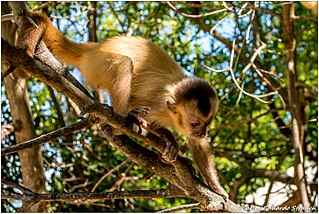
The Cebidae are one of the five families of New World monkeys now recognised. Extant members are the capuchin and squirrel monkeys. These species are found throughout tropical and subtropical South and Central America.

The Panamanian white-faced capuchin, also known as the Panamanian white-headed capuchin or Central American white-faced capuchin, is a medium-sized New World monkey of the family Cebidae, subfamily Cebinae. Native to the forests of Central America, the white-faced capuchin is important to rainforest ecology for its role in dispersing seeds and pollen.

The capuchin monkeys are New World monkeys of the subfamily Cebinae. They are readily identified as the "organ grinder" monkey, and have been used in many movies and television shows. The range of capuchin monkeys includes some tropical forests in Central America and South America as far south as northern Argentina. In Central America, where they are called white-faced monkeys ("carablanca"), they usually occupy the wet lowland forests on the Caribbean coast of Costa Rica and Panama and deciduous dry forest on the Pacific coast.

The tufted capuchin, also known as brown capuchin, black-capped capuchin, or pin monkey, is a New World primate from South America and the Caribbean islands of Trinidad and Margarita. As traditionally defined, it is one of the most widespread primates in the Neotropics, but it has recently been recommended considering the black-striped, black and golden-bellied capuchins as separate species in a new genus, thereby effectively limiting the tufted capuchin to the Amazon basin and nearby regions. However, the large-headed capuchin (S. a. macrocephalus), previously defined as a distinct species, has been reclassified as a subspecies of the tufted capuchin, expanding its range east to Peru and Ecuador and south to Bolivia.

White-fronted capuchin can refer to any of a number of species of gracile capuchin monkey which used to be considered as the single species Cebus albifrons. White-fronted capuchins are found in seven different countries in South America: Bolivia, Brazil, Colombia, Venezuela, Ecuador, Peru, and Trinidad and Tobago.

The Kaapori capuchin, also known as the Ka'apor capuchin, is a species of frugivorous, gracile capuchin endemic to the Brazilian Amazon. Their geographical home range is relatively small and is within the most densely populated region of the Amazon. With the strong human presence nearby,C. kaapori has had to deal with very large amounts of disturbances to their habitat and is one of the most endangered of the neotropical primates.
The Maderas Rainforest Conservancy is a nonprofit organization which was established to promote the conservation, protection, and management of Mesoamerican forests and animal and plant biodiversity through education, reforestation, preservation, and by working with local communities, and national and international institutions and universities.

Robust capuchin monkeys are capuchin monkeys in the genus Sapajus. Formerly, all capuchin monkeys were placed in the genus Cebus. Sapajus was erected in 2012 by Jessica Lynch Alfaro et al. to differentiate the robust (tufted) capuchin monkeys from the gracile capuchin monkeys, which remain in Cebus.

Gracile capuchin monkeys are capuchin monkeys in the genus Cebus. At one time all capuchin monkeys were included within the genus Cebus. In 2011, Jessica Lynch Alfaro et al. proposed splitting the genus between the robust capuchin monkeys, such as the tufted capuchin, and the gracile capuchins. The gracile capuchins retain the genus name Cebus, while the robust species have been transferred to Sapajus.

The Colombian white-faced capuchin, also known as the Colombian white-headed capuchin or Colombian white-throated capuchin, is a medium-sized New World monkey of the family Cebidae, subfamily Cebinae. It is native to the extreme eastern portion of Panama and the extreme north-western portion of South America in western Colombia and northwestern Ecuador.

Humboldt's white-fronted capuchin is a species of gracile capuchin monkey. It is found in Colombia, Venezuela, Brazil, and potentially the island of Trinidad.
The Río Cesar white-fronted capuchin is a species of gracile capuchin monkey from the Río Cesar Valley in northern Colombia. It had previously been considered a subspecies of the white-fronted capuchin. Genetic analysis by Jean Boubli in 2012 revealed that the Río Cesar white-fronted capuchin is actually more closely related to the Colombian white-faced capuchin than it is to C. albifrons. Some authors regard it to be a subspecies of the varied white-fronted capuchin.

The brown weeper capuchin or Venezuelan brown capuchin is a species of gracile capuchin monkey endemic to Venezuela, although some sources also consider it to occur on Trinidad.

The varied white-fronted capuchin is a species of gracile capuchin monkey from Colombia. It had been classified as a subspecies of the white-fronted capuchin Genetic analysis by Jean Boubli in 2012 revealed it to be a separate species. Some authors regard the Río Cesar white-fronted capuchin to be a subspecies of the varied white-fronted capuchin.

The Sierra de Perijá white-fronted capuchin is a species of gracile capuchin monkey from Colombia and Venezuela. It had formerly been regarded as a subspecies of the Humboldt's white-fronted capuchin but was reclassified by Mittermeier and Rylands as a separate species in 2013, based on genetic studies by Jean Boubli.

The Marañón white-fronted capuchin also or known as Peruvian white-fronted capuchin or Andean white-fronted capuchin is a species of gracile capuchin monkey from the upper Amazon Basin. It had been regarded as synonymous with the shock-headed capuchin, which was then considered a subspecies of Humboldt's white-fronted capuchin, but it was classified as a separate species by Mittermeier and Rylands based on genetic studies by Boubli.

The shock-headed capuchin is a species of gracile capuchin monkey from Bolivia and Peru. It was previously classified as a subspecies of the Humboldt's white-fronted capuchin, but in 2013 Mittermeier and Rylands elevated it to a separate species, following genetic studies by Boubli et al. in 2012 and Lynch Alfaro et al. in 2010.
Spix's white-fronted capuchin is a species of gracile capuchin monkey. It had previously been classified as a subspecies of the Humboldt's white-fronted capuchin. Following genetic studies by Boubli, et al, Mittermeier and Ryland elevated it to a full species.













